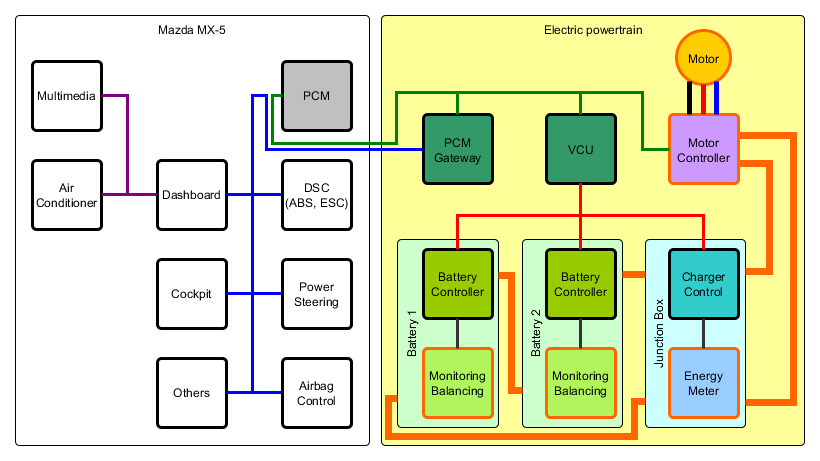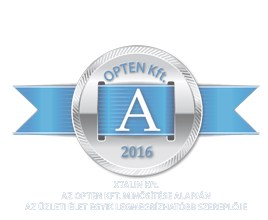Enterprise Communications - Modular Battery System
In 2017 the Industry division of Enterprise Communications Hungary Kft. contacted us to join them for a modular battery development project. Enterprise Group Industry division is one of the leading system integrators in the Hungarian market. With our know-how and several years of experience in electric prototype vehicles, Xtalin has signed a contract for the project. The goal was to develop a lithium-based battery system that can be used for multiple purposes. The project started with finding out what cell chemistry is the most suitable for this project, then extensive cell measurements were run on the most promising cells to find out which one is actually our best option. A collection of 10+ different type of cells went through hundreds of measurement-sequences simulating different environmental conditions, and some were tested for lifecycle through thousands of hours.
The selected cells were fitted in a robust aluminium case and equipped with a completely self-designed Battery Management System which includes all the necessary safety, monitoring and active balancing equipment. All battery modules connect to a single junction box – where beside the safety measures like insulation monitoring – the State of Charge and real-time internal resistance measurements are performed. The power is distributed from the junction box to the high-power motor controller and to the DCDC converters and charger.
The main design aspects were safety and usability; therefore the total system was designed to be one fault tolerant, which means one failure cannot create a critical/fatal situation, the first failure is detected and operation is prevented before the second and critical failure could happen.
Electric test vehicle – Mazda MX-5 conversion
We also published 20 longer articles on the project in Hungarian: https://apexnews.blog.hu/tags/emx5
These modular batteries aim for industrial and heavy vehicles or marine application. However real-life testing was easier to carry out on a passenger car. A used Mazda MX-5 ND was selected to be the base vehicle for conversion. While Enterprise carried out most of the mechanical design to be able to convert the combustion roadster to full electric, Xtalin’s engineers worked on integrating the self-developed battery system with the Mazda’s own electronics and tractive system.
We made a series of articles about the conversion on the ApexNews blog, which were shared regularly by totalcar. As a result, the articles usually have 4,000 to 20,000 views.
First, the system had to be understood. The important CAN-bus messages related to the engine had to be reverse engineered, so all functions (such as brake boost, power steering) could work the same with the electric motor. At the end, the car itself had no idea of the engine swap.
The test vehicle was equipped with 12kWh battery. Two modular batteries were fitted in the car: one module was placed in the engine bay in a single housing to reduce size, and one other battery module was placed in the trunk. As the goal of this vehicle was to collect real-life data and improve the battery system, not to produce a negotiable EV, high range or air conditioner was not necessary for example. A highly efficient 42kW permanent magnet motor and a high current controller were selected to match with the battery’s capability. Both are water-cooled with a custom cooling system. The required high current and control logic wire harnesses were designed and manufactured in-house. A PC telemetry software was developed in JAVA to monitor the parameters of the battery system through a diagnostic port or Wi-Fi. Also, an Android application was made to illustrate the real-time data coming from the Wi-Fi hotspot of battery system. The collected data during vehicle tests was used to validate our design, improve functionality, usability and safety.
Most of the self-developed embedded systems are based on STM ARM microcontrollers, we use them for several years now with excellent experience. Tools provided by the manufacturer makes the hardware and software development easier. Devices with multiple time critical tasks run real-time operating system, while simpler monitoring and command executing electronics perform without the complexity of an OS.
Communication lines in the test vehicle are separated based on functionality. The modular battery system has its own CAN network by design (thin red lines in the diagram below), where the Vehicle Control Unit creates link between the vehicle and the battery system. Furthermore, every battery has its own isolated internal CAN network (black), where the cell monitoring and active balancing are connected. The Motor Controller and the car original Powertrain Control Module is connected to different CAN-bus performing the communication required for calculating torque demands in the VCU. The vehicle own CAN (blue) is separated from the electric drivetrain by a gateway electronics (a failure cannot affect communication in the other system).

To improve software engineering capabilities, a universal self-developed CAN bootloader was implemented in most of the microcontrollers. This helps updating software versions for out of reach devices.
Battery pack for an electric boat – Flaar 5.7E
Later, a specific version of the battery system was created for an electric boat designed and manufactured by Flaar Performance Sailing. We cooperated in the battery housing and the structural design of the boat, therefore the hull and the shape of the battery developed together into the best optimal solution. The battery housing integrates two modules of the modular battery system and all required parts excluding the onboard charger, therefore it provides a robust complete solution for customers. This prototype was presented at the Budapest Boat Show in February 2019, where we received 3rd place award in innovation category.
The biggest difference compared to the electric MX-5 on tractive system side is that the Flaar 5.7E is a product, requiring to fulfil both electric and marine standards, regulations, and pass conformance test.
*the plexi cover was used for demonstration purposes only.
Competencies used in this project:
- Embedded HW design
- Complex system design
- Multilayer PCB
- Up to 600V (insulation, creepage)
- Embedded SW design
- Complex fail-safe functions
- Real-time OS
- CAN-bootloader
- Other SW design
- PC diagnostic
- Android app
- Wire harness
- High current, high voltage (<600V) wiring
- Low voltage
- Mechanical design
- Guidance for stress and tolerance calculations
- Designing simple brackets
- Cooling
- Manual labour
- Dis/assembly of the batteries
- Test vehicle conversion to EV
- Manufacturing wire harnesses
- Measurement
- Develop/improve measurement equipment
- Automated measurements and data collection
- Test plans
- Production management
- Ordering components
- Coordinating PCB manufacturing service
- Coordinating machining service
- Project management




















































